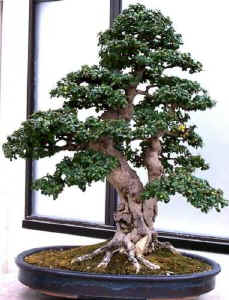There is a strain of prejudice, thankfully getting rarer but still to be found, that holds that only plant material traditionally used in Japan is suitable or 'best' for bonsai. A related train of thought holds that only the Japanese style models are to be used for bonsai
 Short answer, to borrow a phrase from General Norman Schwarzkopf is that those ideas are "bovine scatology". The photo in the upper left shows a standard issue, commercially produce Fukien Tea tree. These are cranked out the same way that chain restaurants produce hamburgers, and conforms to the image of a bonsai for many. It roughly follows some of the design rules we'd like to see in a bonsai and would provide great potential for further refinement.
Short answer, to borrow a phrase from General Norman Schwarzkopf is that those ideas are "bovine scatology". The photo in the upper left shows a standard issue, commercially produce Fukien Tea tree. These are cranked out the same way that chain restaurants produce hamburgers, and conforms to the image of a bonsai for many. It roughly follows some of the design rules we'd like to see in a bonsai and would provide great potential for further refinement.The photo to the right is the same type of plant. From a design stand point
this example is much less appealing. The design concepts of pleasing bonsai
are essentially missing.
 The third example is again the same type of tree, but here obviously guided by a skilled and experienced hand. These examples were chosen because Fukien Tea is widely used as a bonsai/penjing subject in China and many other places. It is not a traditional subject in Japan however. Does that mean it is somehow 'lesser' in some way? I'd say no. It is not a Japanese Black Pine or Japanese Maple. It is wisely not styled in the traditional styles associated with pines or maples. That is the key to success here, the tree has been styled in an appropriate way for the growth pattern and natural
The third example is again the same type of tree, but here obviously guided by a skilled and experienced hand. These examples were chosen because Fukien Tea is widely used as a bonsai/penjing subject in China and many other places. It is not a traditional subject in Japan however. Does that mean it is somehow 'lesser' in some way? I'd say no. It is not a Japanese Black Pine or Japanese Maple. It is wisely not styled in the traditional styles associated with pines or maples. That is the key to success here, the tree has been styled in an appropriate way for the growth pattern and naturaltendencies of the tree.
Imposing what the stylist wants on a tree rather than observing what
nature has already formed and what is with in the specie's natural capacity is the first step to bonsai failure. A prostrate juniper would never make an upright bonsai. The natural tendency to curve and bend would be a handicap for a style that is all about angles and straight lines. Trying to impose an upright style on that tree would be a long,hard and likely frustrating fight. Choosing a plant with upright habit built into its gene's would be the better choice. That prostrate juniper would be better utilized as a cascade. But with clever management, the prostrate juniper could also be a great informal upright
Every tree has the potential to become that 'great specimen' if its natural potential and capabilities are utilized.

No comments:
Post a Comment